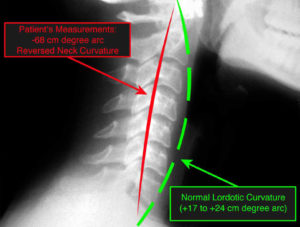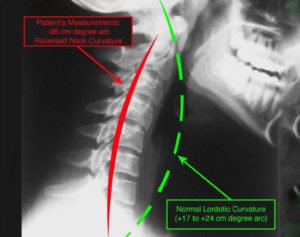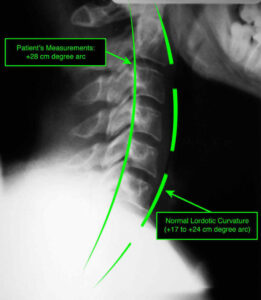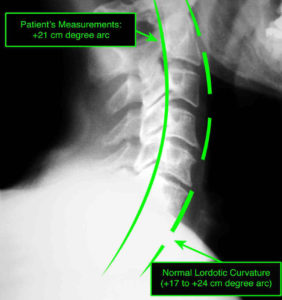Here is the Proof You All Want to See!
What is normal lordotic curvature?
What is normal lordotic curvature?
Barring any rare birth abnormalities or physical trauma early in your life, after you are born your cervical spine (neck) naturally develops a curve referred to as normal cervical lordotic curvature.
When viewed in an x-ray, this is shown as a slight curvature from the base of the skull to the bottom of the neck that gently curves towards the chin. The neck’s normal curvature is typically within a +17cm to +24cm degree arc (the green lines in the image to the left).
This position is the natural way your neck should rest when you stand or sit looking straight ahead, referred to as your neck’s natural rested state.
When a person’s neck is outside of this normal range, our treatment of thousands of patients along with extensive medical studies have shown that ailments such as:
degenerative cervical arthritis, herniated discs, headaches, carpal tunnel, loss of range of motion, neck and shoulder pain, snoring, tight muscles, muscle spasms, inability to sleep through the night without waking and other pain is experienced much more frequently than in individuals with normal neck curvature.
In addition, the longer one’s neck is in an abnormal state, the more likely these symptoms are to increase in frequency and severity.
And now a sample of what we found…
The case studies below include actual x-rays of subjects taken while lying on a Dr. Marink’s pillow as well as other pillow designs that claim their pillows position the neck in a natural state. The details are below but here’s an overview of what we found:
- | Most pillows that claim to position the neck in the proper anatomical position do not do so.
- | Dr. Marink’s pillows allow the cervical spine to achieve normal lordotic curvature. This effect occurred in patients who naturally have a normal lordotic curve, as well as those who don’t.
Below are x-rays of
5 Case Study Subjects
They will be
referred to as:
Patients A through E.
The green lines in the x-ray images
represent normal lordotic curvature.
The red lines indicate abnormal kyphotic curvature.
Patient “A”
Patient A – Standing
(Reversed Neck Curvature – 68cm deg arc)
Patient A – On Dr. Marink’s Back Sleeper
(Normal Neck Curvature +26cm deg arc)
Patient A – On polyester-filled pillow
(Reversed Neck Curvature -150cm deg arc)
Patient “A”
Patient “A” has lost her normal natural lordotic cervical curvature due to an injury.
- The first image depicts the subject’s neck while standing and naturally holding her head upright. It shows the neck has an abnormal kyphotic curvature, or a reversed curve.
- The center image shows that the subject’s neck is restored to near normal lordotic curvature while she rests her head on a Dr. Marink’s pillow.
- The last image shows that the subject’s abnormal curvature of the neck remains when resting her head on the polyester-filled pillow she typically uses at home. This abnormal curvature remains because the pillow does not offer the proper support.
Patient “B”
Patient B – Standing
(Reversed Neck Curvature – 26cm deg arc)
Patient B – On Dr. Marink’s Back Sleeper
(Neck Curvature +30cm deg arc)
Patient B – On down-filled pillow
(Reversed Neck Curvature -66cm deg arc)
Patient “B”
Patient “B” has lost her normal natural lordotic cervical curvature due to an injury.
- The first image depicts the subject’s neck while standing and naturally holding her head upright. It shows the neck has abnormal kyphotic curvature, or a reversed curve.
- The center image shows that the subject’s neck is restored to near normal lordotic curvature when she rests her head on a Dr. Marink’s pillow.
- The last image shows that the subject’s abnormal curvature of the neck remains when resting her head on the down-filled pillow she typically uses at home. This abnormal curvature remains because the pillow does not offer the proper support.
Patient “C”
Patient C – Standing
(Reversed Neck Curvature – 130cm deg arc)
Patient C – On Dr. Marink’s Back Sleeper
(Neck Curvature +28cm deg arc)
Patient C – On down-filled pillow
(Reversed Neck Curvature +50cm deg arc)
Patient C – On down-filled pillow
(Reverse Neck Curvature -130cm deg arc)
Patient “C”
Patient “C” has lost her normal natural lordotic cervical curvature due to an injury.
- The first image depicts the subject’s neck while standing and naturally holding her head upright. It shows the neck has abnormal lordotic curvature, or a reversed curve.
- The center image shows that the subject’s neck is restored to near normal lordotic curvature when she rests her head on a Dr. Marink’s pillow.
- The last two images show that the subject’s abnormal curvature of the neck remains when resting her head on two different popular premium pillows. This abnormal curvature remains because the pillows do not offer the proper support.
Patient “D”
Patient D – Standing
(Reversed Neck Curvature +20 cm deg arc)
Patient D – On Dr. Marink’s Back Sleeper
(Neck Curvature +21cm deg arc)
Patient D – On down-filled pillow
(Reversed Neck Curvature +43cm deg arc)
Patient D – On down-filled pillow
(Reverse Neck Curvature +100cm deg arc)
Patient “D”
Patient “D” has normal natural lordotic cervical curvature.
- The first image depicts the subject’s neck while standing and naturally holding her head upright. It shows the neck has normal lordotic curvature.
- The center image shows that the subject’s normal lordotic curvature is maintained when she rests her head on a Dr. Marink’s pillow.
- The last two images show that the subject has abnormal curvature of the neck when resting her head on another two popular premium pillow even though it is not naturally abnormal. This abnormal curvature occurs because the pillows do not offer the proper support.
Patient “E”
Patient E – Standing
(Normal Neck Curvature +17cm deg arc)
Patient E – On Dr. Marink’s
(Normal Neck Curvature +21cm deg arc)
Patient E – On shredded foam-filled pillow
(Straight Neck -500cm deg arc)
Patient “E”
Patient “D” has normal natural lordotic cervical curvature.
- The first image depicts the subject’s neck while standing and naturally holding her head upright. It shows that the neck has normal lordotic curvature.
- The center image shows that the subject’s normal lordotic curvature is maintained when she rests her head on a Dr. Marink’s pillow.
- The last image shows that the subject has abnormal curvature of the neck when resting her head on another popular premium pillow even though it is not naturally abnormal. This abnormal curvature occurs because the pillow does not offer the proper support.
Patient “F”
Patient F – Standing
(Reverse Neck Curvature -130cm deg arc)
Patient F – On Dr. Marink’s
(Normal Neck Curvature +24cm deg arc)
Patient F – On down-filled pillow
(Reverse Neck Curvature -55cm deg arc)
Patient “F”
Patient “E” has lost normal natural lordotic cervical curvature due to an injury.
- The first image depicts the subject’s neck while standing and naturally holding her head upright. It shows that the neck has abnormal lordotic curvature, or a reversed curve.
- The center image shows the subject’s neck is restored to near normal lordotic curvature when she rests her head on a Dr. Marink’s pillow.
- The last image shows that the subject’s abnormal curvature of the neck remains when resting her head on a premium down pillow. This abnormal curvature remains because the pillow does not offer the proper support





















